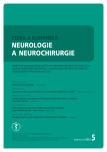Idiopathic Hypertrophic Cranial Pachymeningitis – Two Case Reports
Authors:
Z. Pavelek 1; P. Ryška 2; J. Žižka 2; S. Plíšek 3; M. Vališ 1
Authors‘ workplace:
Neurologická klinika, LF UK a FN Hradec Králové
1; Radiologická klinika, LF UK a FN Hradec Králové
2; Klinika infekčních nemocí, LF UK a FN Hradec Králové
3
Published in:
Cesk Slov Neurol N 2016; 79/112(5): 604-607
Category:
Case Report
Overview
Idiopathic hypertrophic cranial pachymeningitis (IHCP) is an extremely rare disease of unknown origin. It is a fibrosing chronic inflammatory process that affects intracranial dura mater. The clinical picture can be heterogeneous including headache, ataxia, seizures and cranial nerve palsy. Cranial nerve palsy is caused by compression of the exit zone of the nerve roots by hypertrophic basal pachymeningitis. IHCP can even imitate transient ischemic attack. Common haematological abnormal findings include elevated C-reactive protein and elevated blood sedimentation. Findings in cerebrospinal fluid usually show a chronic aseptic process. Magnetic resonance imaging (MRI) is the most important diagnostic method. MRI finds a diffusely thickened dura that enhances after paramagnetic contrast injection. The course of disease is chronic and progressive and includes frequent recurrences. Corticosteroid therapy should be the first approach in IHCP, useful is a combination with azathioprine, cyclophosphamide or methotrexate. Resistant cases can profit from radiotherapy or surgery. We report two cases from our own patient base through which we demonstrate the course, diagnostics and therapy of this disorder.
Key words:
pachymeningitis – magnetic resonance imaging – thickening of dura mater
The authors declare they have no potential conflicts of interest concerning drugs, products, or services used in the study.
The Editorial Board declares that the manuscript met the ICMJE “uniform requirements” for biomedical papers.
Sources
1. Karakasis C, Deretzi G, Rudolf J, et al. Long-term lack of progression after initial treatment of idiopathic hypertrophic pachymeningitis. J Clin Neurosci 2012; 19 (2): 321–3. doi: 10.1016/j.jocn.2011.05.020.
2. Martin N, Masson C, Henin D, et al. Hypertrophic cranial pachymeningitis: assessment with CT and MR imaging. AJNR Am J Neuroradiol 1989; 10: 477–84.
3. Rossi S, Giannini F, Cerase A, et al. Uncommon findings in idiopathic hypertrophic cranial pachymeningitis. J Neurol 2004; 251 (5): 548–55.
4. Smolders D, De Foer B, Pouillon M, et al. Idiopathic hypertrophic cranial pachymeningitis. JBR-BTR 2002; 85 (3): 154–5.
5. Sylaja PN, Cherian PJ, Das CK, et al. Idiopathic hypertrophic cranial pachymeningitis. Neurol India 2002; 50 (1): 53–9.
6. Yonekawa T, Murai H, Utsuki S, et al. A nationwide survey of hypertrophic pachymeningitis in Japan. J Neurol Neurosurg Psychiatry 2014; 85 (7): 732–9. doi: 10.1136/jnnp-2013-306410.
7. Kang SY, Choi JC, Kang JH. Idiopathic hypertrophic pachymeningitis presented with abducens nerve palsy. J Korean Neurol Assoc 2005; 23 (3): 431–3.
8. Mamelak AN, Kelly WM, Davis RL, et al. Idiopathic hypertrophic cranial pachymeningitis. Report of three cases. J Neurosurg 1993; 79 (2): 270–6.
9. Mathew RG, Hogarth KM, Coombes A. Idiopathic hypertrophic cranial pachymeningitis presenting as acute painless visual loss. International Ophthalmology 2012; 32 (2): 195–7. doi: 10.1007/s10792-012-9536-2.
10. Fan Y, Liao S, Yu J, et al. Idiopathic hypertrophic cranial pachymeningitis manifested by transient ischemic attack. Med Sci Monit 2009; 15 (12): CS178–81.
11. Phanthumchinda K, Sinsawaiwong S, Hemachudha T, et al. Idiopathic hypertrophic cranial pachymeningitis: an unusual cause of subacute and chronic headache. Headache 1997; 37 (4): 249–52.
12. Phanthumchinda K. Idiopathic hypertrophic cranial pachymeningitis: an emerging inflamatory meningeal syndrome. J Clin Neurosci 1997; 150: 310.
13. Rumboldt Z. Brain Imaging with MRI and CT. Cambridge: UP 2012.
14. Lee YC, Chueng YC, Hsu SW, et al. Idiopathic hypertrophic cranial pachymeningitis: a case report with 7 years of imaging follow-up. AJNR Am J Neuroradiol 2003; 24 (1): 119–23.
15. Bosman T, Simonin C, Launay D, et al. Idiopathic hypertrophic cranial pachymeningitis treated by oral methotrexate: a case report and review of literature. Rheumatol Int 2008; 28 (7): 713–8.
16. Zhu R, He Z, Ren Y. Idiopathic hypertrophic craniocervical pachymeningitis. Eur Spine J 2015; 24: S633–5. doi: 10.1007/s00586-015-3956-4.
17. Nishio S, Morioka T, Togawa A, et al. Spontaneous resolution of hypertrophic cranial pachymeningitis. Neurosurg Rev 1995; 18 (3): 201–4.
18. Qin LX, Wang CY, Hu ZP, et al. Idiopathic hypertrophic spinal pachymeningitis: a case report and review of literature. Eur Spine J 2015; 24 (Suppl 4): S636–43. doi: 10.1007/s00586-015-3958-2.
19. Miyake K, Okada M, Hatakeyama T, et al. Usefulness of L-methyl-11c-methionine positron emission tomography in the treatment of idiopathic hypertrophic cranial pachymeningitis – a case report. Neurol Med Chir (Tokyo) 2012; 52 (10): 765–9.
20. Takuma H, Shimada H, Inoue Y, et al. Hypertrophic pachymeningitis with anti-neutrophil cytoplasmic antibody (p-ANCA), and diabetes insipidus. Acta Neurol Scand 2001; 104 (6): 397–401.
Labels
Paediatric neurology Neurosurgery NeurologyArticle was published in
Czech and Slovak Neurology and Neurosurgery

2016 Issue 5
Most read in this issue
- Current Corticosteroid Treatment in Brain Tumours
- Rasmussen’s Encephalitis
- Traumatic Brachial Plexus Injuries Represents Serious Peripheral Nerve Palsies
- Detection of Spirochetal DNA from Patients with Neuroborreliosis
